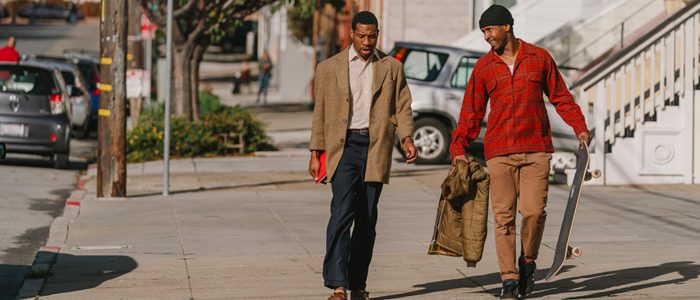‘The Last Black Man in San Francisco’ Review: A Poetic Tale of Gentrification and Friendship [Sundance]

At last year’s Sundance Film Festival, both Blindspotting and Sorry to Bother You weaved Oakland’s gentrification into their underlying stories. At this year’s fest, co-writer/director and fifth generation San Franciscan Joe Talbot addresses the subject in an even more direct way with his memorable debut film, The Last Black Man in San Francisco.
Jimmie (an excellent Jimmie Fails, who has a “story by” credit on the script and plays a character inspired by his own life) and Mont (a superb Jonathan Majors) have been best friends for years, riding through the streets of San Francisco on a shared skateboard and struggling to stay afloat in a city that’s rapidly leaving them behind. Jimmie crashes with Mont and Mont’s blind father (Danny Glover) at their house, sharing a tiny room with Mont and spending nights with the family in the living room watching classic movies as Mont narrates for his dad.
Every two weeks, Jimmie heads across town to a gorgeous Victorian house and paints the trim, takes care of the garden, and generally keeps the place looking good. Jimmie’s grandfather, the so-called “first black man in San Francisco,” designed and built the house with his own hands after World War II, and though Jimmy spent his childhood living there, his family was eventually priced out of the neighborhood and it was bought by a white couple who don’t appreciate Jimmie’s continual efforts to improve the house. When the current owners experience a death in the family and leave the house empty, Jimmie takes the opportunity to move in and reclaim what he sees as rightfully his, bringing Mont – an artist developing a play about one of the tough-talking bullies always standing on the corner – along for the ride.
Talbot, a first-time feature filmmaker, takes a lyrical, poetic approach to the storytelling, creating vignettes that paint a larger picture about whether anything can ever truly be owned, how family relationships can be their own sort of trap, how history can connect you to a place even when the world refuses to acknowledge that connection, and how art can illuminate truths that would may otherwise have gone unspoken. The result is a tapestry of memorable moments: a street preacher lamenting the fact that workers in hazmat suits are finally cleaning up the city’s water now that white people are paying attention, There’s a beautiful sequence in which the protagonists’ bodies are compared to the city’s houses; “we are these homes,” one of them says, and Talbot intercuts images of their eyes with windows, their beanies with the “witch hat” rooftop tower, and their wind-swept shirt tails with curtains flapping in the breeze. There is no separation between the city and its people – the two entities are inextricable.
A warm, funny movie about legacy, loss, and the strength to move forward, The Last Black Man in San Francisco is a touching drama that cares deeply about the people San Francisco has forgotten. “People aren’t one thing,” Jimmie says at one point, tapping into the way the movie continually peels back the layers of its characters. Our actions define us, but our history doesn’t have to be a prison. Starting a new chapter is only one page turn away.
A24 has picked up this film for distribution, but hasn’t set an official release date yet.
/Film Rating: 8 out of 10
The post ‘The Last Black Man in San Francisco’ Review: A Poetic Tale of Gentrification and Friendship [Sundance] appeared first on /Film.
from /Film http://bit.ly/2FYUgUQ
via IFTTT
Comments
Post a Comment